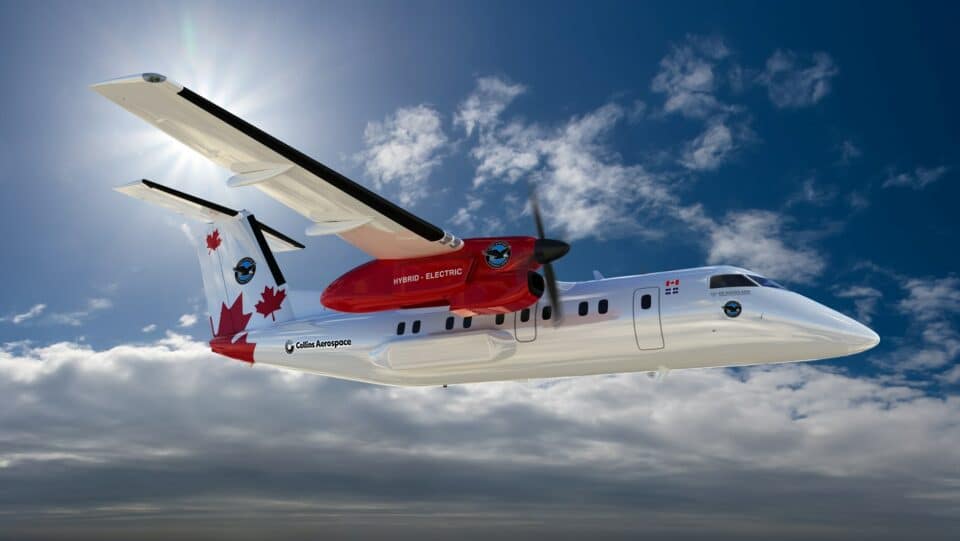Aerospace
RTX advances hybrid-electric propulsion for Dash 8 Testing

RTX has completed a crucial milestone in its hybrid-electric flight demonstrator programme, successfully completing a rated power test of the demonstrator’s 1 megawatt (MW) electric motor built by Collins Aerospace.
The 1MW motor will be connected to a highly efficient thermal engine built by Pratt & Whitney as part of a hybrid-electric propulsion system that seeks to provide a 30% improvement in fuel efficiency and CO2 emissions over today’s most sophisticated regional turboprops. Collins and Pratt & Whitney are both RTX business units.
The 1MW motor will provide four times the power and twice the voltage, with half the heat loss and half the weight compared to Collins’ most cutting-edge electric motor generators now in flight. At Collins’ site in Solihull, England, the business is creating the motor, and the Institute for Aerospace Technology at the University of Nottingham is where it is being tested.
The propulsion system and batteries will be integrated on a Dash 8-100 experimental aircraft, with flight testing targeted to begin in 2024. The project is supported by the governments of Canada and Quebec.
Clean Aviation SWITCH Project to Advance Hybrid-Electric(Opens in a new browser tab)
The 1MW motor will also be a part of the Pratt & Whitney GTFTM hybrid-electric powertrain intended for the SWITCH project under the European Union’s Clean Aviation policy, in addition to the hybrid-electric flight demonstrator. The Grid, a $50 million electric power systems lab at Collins’ Rockford, Illinois, plant scheduled to open later this year, will host further testing.

Aerospace
Boeing Transfers Rocket Stage to NASA, Paving Way for Human Moon Mission

Boeing has achieved a significant milestone by providing NASA with the second core stage of the Space Launch System (SLS) rocket.
This crucial component, crafted at NASA’s Michoud Assembly Facility (MAF), is set to propel the Artemis II crew into lunar orbit, marking humanity’s return to deep space after a 50-year hiatus.
The monumental Boeing-built rocket stage, the largest element of the Artemis II mission, will embark on a journey aboard the Pegasus barge, traveling 900 miles to NASA’s Kennedy Space Center.
Comparison of two legendary aircraft B777x vs B747 aircraft:Click here
Upon arrival, it will be meticulously integrated with other essential Artemis II components, including the upper stage, solid rocket boosters, and NASA’s Orion spacecraft within the iconic Vehicle Assembly Building. This intricate integration process is a vital step toward the eagerly anticipated Artemis II launch, slated for 2025.
“Boeing-built products helped land humankind on the moon in 1969, and we’re proud to continue that legacy through the Artemis generation,” remarked Dave Dutcher, vice president and program manager for Boeing’s SLS program. “Together, with NASA and our industry partners and suppliers, we are building the world’s most capable rocket and paving the way to deep space through America’s rocket factory in New Orleans.”
NASA, Lockheed Martin Reveal X-59 Quiet Supersonic Aircraft:Click here
The delivery of Core Stage 2 marks a significant achievement in the evolution of the SLS rocket. Towering over 200 feet and powered by four RS-25 engines, this core stage, coupled with two solid-fueled booster rockets, will generate a staggering 8.8 million pounds of thrust. This immense power is crucial to launching Artemis II and future missions into the vast expanse of space.
The SLS rocket stands unparalleled in its capability to transport both crew and substantial cargo to the moon and beyond in a single launch. Its extraordinary capacity will facilitate the delivery of human-rated spacecraft, habitats, and scientific missions to destinations including the moon and Mars, ushering in a new era of space exploration.
-

 Travel1 week ago
Travel1 week agoAir India to Expand US Operations with Three New Routes After a Decade
-

 Travel2 weeks ago
Travel2 weeks agoWhy We Should Avoid These Stamps in a Passport
-

 Airlines1 month ago
Airlines1 month agoInvestigations Reveal Fake Chinese Titanium in Boeing and Airbus Jets
-

 Tech4 weeks ago
Tech4 weeks agoChina’s CATL Plans 1,800-Mile Electric Plane Launch by 2027
-

 Airport3 days ago
Airport3 days agoTop 10 Largest Airports in the World by Size
-

 Aerospace4 weeks ago
Aerospace4 weeks agoChina’s Fighter Jets Turn Wings into Autonomous Drones
-

 Airlines4 days ago
Airlines4 days agoAir India Rolls Out A350s for Delhi-New York JFK and Newark Routes
-

 Defence3 weeks ago
Defence3 weeks agoBoeing Enhances Chinook with New Engines and Block II Upgrades at $96 Million







